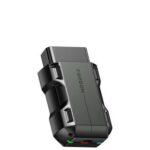For any car owner in the UK who likes to get their hands dirty with DIY car maintenance, an OBD2 scanner is quickly becoming an indispensable tool. In today’s world of complex vehicle electronics, understanding what’s going on under the bonnet requires more than just a wrench and some elbow grease. The ability to read engine fault codes is now crucial for diagnosing and fixing problems in modern cars and vans right in your own garage or driveway.
Are OBD scanners really worth the investment for the home mechanic? Absolutely. They represent the fastest and most efficient route to pinpointing car troubles. Without a DIY OBD2 scanner, you’re often left with no choice but to visit a professional garage just to have the fault code read. Considering that hourly labour rates at independent garages in the UK average around £50, these costs can quickly add up. However, by pairing a quality OBD fault code reader with resources like Haynes AutoFix, you gain the power to diagnose and repair a vast range of common faults and electrical issues yourself, using your own tools and on your own schedule.
The market is flooded with OBD readers, offering a wide spectrum of features and price points. While the advanced, more expensive models boast a plethora of functionalities, the core purpose remains consistent across the board. Importantly, many of these devices are priced lower than a single diagnostic trip to a garage. But with so many options available, which is the best DIY OBD2 scanner for your needs in the UK?
Understanding the Basics of an OBD2 Reader
Traditionally, an OBD reader has been a handheld diagnostic device acting as a communicator with your car’s computer system. Its primary function is to interpret fault codes, among other diagnostic data. You can find OBD scanners for as little as £10, while professional-grade tools can reach into the hundreds of pounds. Despite the price variations and feature sets, all OBD2 scanners should, at a minimum, be capable of:
- Establishing communication with your vehicle’s system
- Reading and displaying fault codes
- Clearing stored fault codes
It’s important to note that many basic OBD2 scanners will not handle tasks like turning off service lights or resetting oil life management monitors, including systems like ABS and SRS. For these more advanced procedures, resources like Haynes AutoFix provide step-by-step guidance to help you through these processes.
Search for Haynes AutoFix for my car now
How OBD2 Technology Works
OBD stands for On-Board Diagnostics. The OBD system is accessed through a specific port in your car, which visually resembles an older style SCART connector. Since 1st January 2001, all petrol passenger cars sold in the UK have been mandated to include an OBD port. This requirement extended to diesel vehicles from 2004 onwards. This standardized 16-pin socket is known as OBD2 in most parts of the world, but in Europe, it’s specifically referred to as EOBD (European On-Board Diagnostics).
The OBD2 socket is not just a data port; it also supplies power. This clever design means that your OBD2 scanner doesn’t need its own power source, eliminating the need for batteries or separate power cables, making it convenient and easy to use for quick DIY diagnostics.
